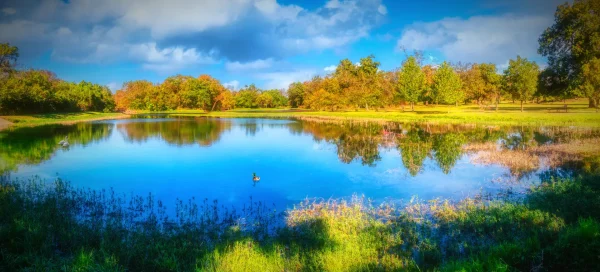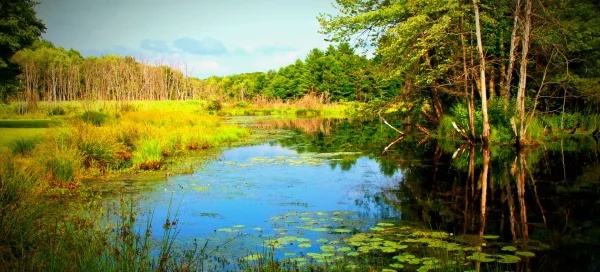Overview
The Clown Featherback, scientifically known as Chitala ornata, is a distinctive freshwater fish from the Notopteridae family. Native to the freshwater habitats of Southeast Asia, this species is known for its elongated body and striking appearance. It can grow substantially and is characterized by its knife-like body shape and beautiful, ornate patterns.
This fish is particularly notable for its large, silver body marked with black spots and stripes, which gives it a unique and eye-catching appearance. ‘Featherback’ refers to its long, undulating dorsal fin, which runs along much of its body length and resembles a feather. This fin and its slender body allow for graceful and efficient movement in the water. The Clown Featherback is a popular species in the aquarium trade, appreciated for its beauty and distinctive morphology.
Clown Featherbacks are predators in their natural habitat, feeding primarily on smaller fish and invertebrates. They are known for their hunting prowess, using their slender bodies to maneuver quickly and catch prey. This species is often found in slow-moving or standing waters, such as lakes, swamps, and large rivers. Their adaptability to different freshwater environments is key to their widespread distribution across Southeast Asia.
Taxonomy
Kingdom
Phylum
Class
Order
Family
Genus
Species
Type
Physical Description:
The Clown Featherback is known for its elongated, laterally compressed body, silver with black spots and stripes. The body shape is reminiscent of a knife blade, contributing to the common name ‘featherback.’ This streamlined form facilitates quick, darting movements in the water. The most striking feature is the long, continuous dorsal fin, which starts near the head and extends almost to the tail.
The dorsal fin is thin and undulating, used for precise movements in water. The species lacks a pelvic fin, a common trait among the Notopteridae family. The anal fin is also elongated, balancing the long dorsal fin and aiding in swimming. The Clown Featherback has a small, upturned mouth, indicating its surface-feeding habits.

Lifespan: Wild: ~10 Years || Captivity: ~12 Years

Weight: Male & Female: 11 lbs (5 kg)

Length: Male & Female: 40 inches (100 cm)
Characteristic:
Native Habitat:
Clown Featherbacks are native to the freshwater systems of Southeast Asia, including Thailand, Cambodia, Laos, and Vietnam. They inhabit various freshwater environments, from large rivers and streams to lakes and flooded forests. These habitats often have slow-moving or still water, which the species prefer.
The water in their natural habitat is typically warm and slightly acidic to neutral. They are well-adapted to environments with dense vegetation, which provides shelter and hunting grounds. Their ability to inhabit various freshwater environments has contributed to the widespread distribution of the Clown Featherback within its native range.
Climate Zones:
Biomes:
WWF Biomes:
Biogeographical Realms:
Continents:
Countries:
Diet:
Diet & Feeding Habits:
Clown Featherbacks are carnivorous, preying mainly on smaller fish and aquatic invertebrates. They are skilled hunters, utilizing their speed and agility to catch prey. The species is known for being opportunistic, feeding on whatever prey is available in their environment, including insects, crustaceans, and other small aquatic organisms.
In the wild, they often hunt in shallow waters with abundant prey. Their upturned mouths are well-suited for surface feeding. In aquarium settings, they can be fed various foods, including live and frozen prey and commercially prepared fish foods. Captive diets need to be varied and nutritionally balanced to maintain health.
Mating Behavior:
Mating Description:
Little is known about the clown featherback’s specific mating behaviors in the wild. Like many freshwater fish, clown featherbacks are likely to have seasonal breeding patterns influenced by environmental factors such as water temperature and food availability. During the breeding season, males may display more vibrant colors or engage in specific behaviors to attract females.
The species is known to lay eggs, which are then fertilized externally. The parental investment post-fertilization is not well documented, but there is little to no parental care in many similar species. In aquarium settings, breeding Clown Featherbacks can be challenging due to their size and specific environmental requirements for successful spawning.
Reproduction Season:
Birth Type:
Pregnancy Duration:
Female Name:
Male Name:
Baby Name:
Social Structure Description:
Clown Featherbacks are generally solitary, especially outside of the breeding season. They are predatory and territorial, often defending their chosen area from other fish. This solitary nature is typical of many predatory freshwater fish species.
During the breeding season, individuals may interact for reproduction. However, detailed observations of their social behavior in the wild are limited. Their territorial nature must be considered in aquarium settings when housing them with other fish.
Groups:
Conservation Status:
Population Trend:
There is limited specific information on the population status of Clown Featherbacks in the wild. However, like many species in Southeast Asia, they face threats from habitat loss, pollution, and overfishing. The degradation of freshwater habitats due to agricultural and urban development is a significant concern.
In some areas, Clown Featherbacks are fished for food, which may impact local populations. Conservation efforts for freshwater ecosystems in Southeast Asia, in general, are crucial for the sustainability of this species. Monitoring and research are needed to better understand their population dynamics and threats.
Population Threats:
The main threats to Clown Featherbacks include habitat loss due to agricultural and urban development, pollution, and overfishing. Freshwater ecosystems in Southeast Asia are under significant pressure from human activities, which can lead to the degradation of crucial habitats for this species. Agricultural runoff and industrial waste pollution can also impact their health and breeding success.
Overfishing, both for local consumption and the aquarium trade, can lead to declines in their populations. The lack of specific conservation measures or regulations for this species exacerbates these threats. Climate change may also impact their freshwater habitats, although the specific effects are poorly understood.
Conservation Efforts:
Conservation efforts for Clown Featherbacks are not well documented, as the IUCN does not currently evaluate the species. However, the conservation of freshwater ecosystems in Southeast Asia is crucial for the survival of this species. This includes protecting habitats from pollution, regulating fishing practices, and ensuring sustainable regional development.
Education and awareness campaigns can help local communities understand the importance of freshwater biodiversity. Promoting responsible breeding and trading practices in the aquarium trade can reduce pressure on wild populations. Research into their ecology, behavior, and population dynamics is important for informing conservation strategies.
Additional Resources:
Fun Facts
- Clown Featherbacks can breathe air using a specialized lung-like organ to survive in oxygen-poor waters.
- They can make grunting sounds, thought to be used for communication.
- In the aquarium trade, they are prized for their unique body shape and striking coloration.
- Their elongated body and continuous dorsal fin enable them to make sudden and agile movements in the water.
- Clown Featherbacks can eat prey nearly as large as themselves due to their expansive mouths.
- They are known to jump out of the water to catch low-flying insects.
- The species is often mistaken for an eel due to its elongated body but is not closely related to true eels.
- In some regions, Clown Featherbacks are considered a delicacy and are fished for food.
- They are one of the few fish species that can swim backward.
- The species has a strong resilience to changes in water quality, making them a hardy species in fluctuating freshwater environments.






